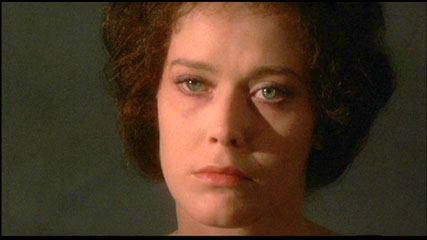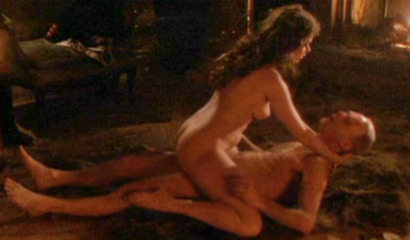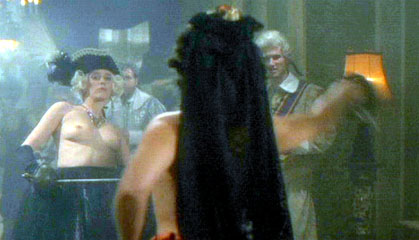|
Another legendary skin-fest has finally come to Region 1 DVD. Sylvia Kristel, the original screen Emmanuelle, was nearing the end of her softcore days when she starred in this film. Although still attractive, she was no longer fresh-faced. She was also either out of shape or pregnant. The director made a special effort to shoot her in soft focus, behind gauze, in fog, through vaseline, through dark filters, and every other trick he could think of to maintain the illusion of youthful beauty. For the most part, his artifices were successful, although you will destroy the carefully maintained illusion if you scrutinize the images too meticulously. If you study the close-ups, you can see that she looks older than they want you to think (below left). If you look at the middle of her body, you'll see saddlebags and a bulging tummy (below right). If you just go with the flow, however, it will seem like 1974 all over again. |
|
|
|
|
|
In fact, the entire concept of this film seems at first to belong in the early 70s. The idea of using a historical person, legend, or epic as the basic for a softcore sex film was all in vogue back in those days. There was the Long Swift Sword of Siegfried, The Undercover Scandals of Henry VIII, The Ribald Tales of Robin Hood, The Erotic Adventures of Zorro, and probably many more that I'm forgetting. As a historical softcore, Mata Hari would fit right in. It isn't really fair to compare Mata Hari with those films, however. They are basically low-budget cheesefests played mostly for laughs and sex. Mata Hari is, astoundingly enough, a serious biopic of the famous alleged double agent, complete with slit throats and grisly World War One battle wounds. Somebody went to a lot of trouble to assemble old-time trains, armaments, uniforms, costumes, trench warfare, and vehicles in an effort to incorporate some period detail. I don't know whether the period artifacts are authentic (some of those 1914 cars looked to me like they were from a much later era, but I'm no expert), but the general look and feel of the film evokes an era circa WW1, at least to this casual observer. So let's give the director credit for what he accomplished. One thing the director couldn't create was the feel of the specific European cities. There just wasn't enough money. In fact, if you pay attention to this film, you'll get the feeling that Europe had a single unified culture in 1914, and that all European cities look exactly alike. The story begins in the streets of Paris (Budapest with French signs), moves to Berlin (Budapest with German signs), and thence to Madrid (Budapest with Spanish signs). In fact, some of the same landmarks in Buda were visible in the background of more than one city! Oh, well. I guess the point is that it looked all old-timey and European, with lots of buildings painted mustard yellow, so that worked OK, and the Indonesian dance number looks quite exotic, whether or not it is authentic. All in all, I give the director credit for the ol' college try. He did what he could to create the right atmosphere, he found some great locales, he worked around Kristel's physical appearance, and in general he did as much as he could have done with the money he had to work with. Unfortunately, the director couldn't do much with the main thing that the film got wrong: the leading lady. Because of her inappropriate physical appearance, she was not an especially good choice for a sex film, but the whole damned film was made to capitalize on her international popularity as a softcore legend. Of course, she was at least passable as the star of the international cut simply because she was Sylvia Kristel and she was undressed. Unfortunately, the film was shown in the United States with the nude love scenes cut out, a disastrous circumstance that forced American audiences to evaluate the film as a legitimate historical drama, and to evaluate Kristel as a legitimate actress. In other words, watching the American version of Mata Hari was like watching Brigadoon without the music. There was simply no reason to release the film in the United States with all those scenes cut out of the picture. It can't pass as an art film or a historical epic, not because it is so god-awful, but mostly because there is just no way any director can get a credible performance from Sylvia. Her biographies always make much of her high I.Q. and her fluency in several languages, but the stark reality is that she could never bring any of that alleged intellect into her acting abilities, and if she speaks English fluently it is not apparent in this English language performance. She always appears to be lifeless, nearly stunned, pronouncing all her lines as if they had been memorized phonetically without understanding them. On the other hand, let's celebrate her for her participation in the one truly memorable thing in this film: a topless swordfight. Now that's entertainment! |
|
|
|
|
| After watching the film, I was going to complain the plot was sort of confusing and lacked specificity. I could never tell precisely who the hell Mata Hari's allegiance belonged to, and I couldn't really understand the significance of what the various sides were asking her to do. I still think that those statements are generally accurate, but I reconsidered the importance of those opinions once I started reading about the real Mata Hari. Although she traveled throughout Europe and was intimate with important men on both sides of the conflict, there is really no evidence to show that she ever turned anything of value over to anyone, and historians have reached no conclusions about where her true loyalties lay. Although the French convicted her of espionage and executed her as a wartime spy, the facts of the case are just as murky and obscure as portrayed in the film. I suppose it is always possible to stray far from the truth and thus create a romantic yarn, but there just wasn't much more the author could have done without altering the unembellished facts. The legend of Mata Hari sounds like it would be a great subject for a film, but the fact of the matter is that the legend is not really justified by what we know about her. The real story of Mata Hari is one of an entertainer traveling through Europe, sleeping with important men, and therefore asked by the men on one side what the men on the other side were doing. That's about it, and that's about what the film showed. | |




